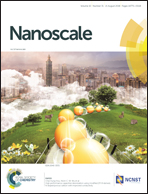Activatable magnetic resonance nanosensor as a potential imaging agent for detecting and discriminating thrombosis†
Abstract
The early detection and accurate characterization of life-threatening diseases such as cardiovascular disease and cancer are critical to the design of treatment. Knowing whether or not a thrombus in a blood vessel is new (fresh) or old (constituted) is very important for physicians to decide a treatment protocol. We have designed smart MRI nano-sensors that can detect, sense and report the stage or progression of cardiovascular diseases such as thrombosis. The nanosensors were functionalized with fibrin-binding peptide to specifically target thrombus and were also labelled with fluorescent dye to enable optical imaging. We have demonstrated that our nanosensors were able to switch between the T1 and T2 signal depending on thrombus age or the presence or absence of thrombin at the thrombus site. The developed nanosensors appeared to be non-toxic when tested with Chinese Hamster Ovarian cells within the tested concentrations. The working principle demonstrated in this study can be applied to many other diseases such as cancer.



 Please wait while we load your content...
Please wait while we load your content...